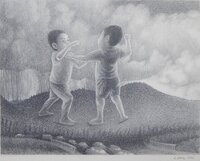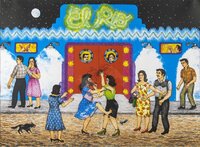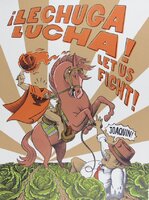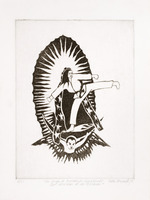Search Results
Subject is exactly
Fighting
Use buttons below to view additional pages.
-

Posada y yo
title Posada y yodescription Linocut, 21/35. Linograbado, 21/35. 11" x 14 3/4" (paper size). From the Posada Presente portfolio.artist/creator Fuentes, Juansubject Posada, José Guadalupe, 1852-1913 Printmaking Arroyo Irony Calacas Calaveras Skeletons 2013 War in art Fighting Death Soldiers Combat Calendario Cities Conflict Homage Calendar artcontributor National Museum of Mexican Art (NMMA) -

Puente
title Puentedescription Graphite on paper, 12 in. x 15 in. Two children fighting in a forest next to a highway.artist/creator Cruz Perez, Albertosubject Children Borderlands Frontera Fighting Graphite pencils Life and Experiences in the U.S./Mexico Borderlands (exhibition)contributor Mexic-Arte Museum (MAM) -

Las Peleoneras
title Las Peleonerasdescription Color lithograph on paper, 32.5 in. x 39.5 in. Two women fighting and pulling each others' hair outside of a dance club while a group of people look on. Chicana artist and illustrator Carmen Lomas Garza created a series of artworks in which she visually shares memories of growing up in Kingsville, Texas. Here, she presents two women fighting in the center of this print. We have no idea why the two rivals are brawling in front of the El Rio bar. On either side of the two women, onlookers watch the fight. Looking through the port windows of the front door, a man and woman observe the combatants with curiosity. Symbolizing anger and treachery, a small black dog barks at the women, while a full moon floats in the dark sky. The artist stimulates our imagination, so that we can complete our own version of her story. A narrative artist, Carmen Lomas Garza is a skillful storyteller who specializes in relating to her Mexican American heritage. Carmen Lomas Garza is an award-winning artist-educator, who was born in Kingsville, Texas in 1948. She attended Texas A & I University (renamed Texas A & M University, Kingsville), Juarez-Lincoln/Antioch Graduate School, and San Francisco State University. The artist is known for her use of papel picado in large ofrendas. She describes her life as an artist: “At the age of thirteen, I decided to become a visual artist and pursue every opportunity to advance my knowledge of art in institutions of higher education. The Chicano Movement of the late 1960s inspired the dedication of my creativity to the depiction of special and everyday events in the lives of Mexican Americans based on my memories and experiences in South Texas. I saw the need to create images that would elicit recognition and appreciation among Mexican Americans, both adults and children, while at the same time serve as a source of education for others not familiar with our culture. It has been my objective since 1969 to make paintings, prints, installations for Day of the Dead, and paper and metal cutouts that instill pride in our history and culture in American society.”artist/creator Garza, Carmen Lomassubject Borderlands Frontera Fighting Bars (Drinking establishments) Color lithographs Lithographs Prints Life and Experiences in the U.S./Mexico Borderlands (exhibition)contributor Mexic-Arte Museum (MAM) -

Lechuga Lucha
title Lechuga Luchadescription Lithograph over color serigraph on tan woven paper, 30 in. x 22.5 in. Headless horseman holding a flaming head of lettuce and looming over his boss who cowering a lettuce field. Image is joined with the text, "Lechuga Lucha!" "Let us Fight!" In this print, a headless rider, wearing a red poncho emblazoned with the UFW (United Farm Workers) logo, encourages migrant farm workers to fight for their labor rights, as a frightened grower cries out, “Joaquin!” The artist references I Am Joaquin, or Yo soy Joaquin, composed by Rodolfo "Corky" Gonzales in 1967, a famous epic poem associated with the Chicano Movement. In the poem, Joaquin (the narrator) speaks of the struggles that the Chicano people have endured to gain economic justice and equal rights in the U.S., as well as to find an identity of being part of a unique Chicano culture. He promises that his culture will survive, if all Chicano people unify and demand social justice. The poet Gonzales outlines 2000 years of Mexican and Chicano history; he traces both his ancestry to the Spanish conquistadors and the Aztecs they "conquered.” He also identifies with revolutionary figures of Mexican history, such as Miguel Hidalgo y Costilla, Benito Juárez, Pancho Villa, and Joaquin Murrieta who was a legendary Californian vaquero and gold miner known for seeking retribution against the Anglo-Americans invaders who hanged his brother and killed his wife. Joaquin Murrieta eventually was captured by a bounty hunter and beheaded. Known as the “Robin Hood of the West,” Murrieta later inspired the creation of the Cisco Kid and Zorro. In 1969, the poem was adapted into a short film by Luis Valdez, a leading figure in Chicano theater and film.artist/creator García, Eric J.subject Borderlands Frontera Lettuce Fighting United Farm Workers (UFW) Lithographs Screen prints Prints Allegory Life and Experiences in the U.S./Mexico Borderlands (exhibition)contributor Mexic-Arte Museum (MAM) -

La Virgen de Guadalupe Defendiendo los Derechos de los Xicanos
title La Virgen de Guadalupe Defendiendo los Derechos de los Xicanosdescription Ester Hernández, La Virgen de Guadalupe Defendiendo los Derechos de los Xicanos, 1975, etching and aquatint on paper, Smithsonian American Art Museum, Museum purchase through the Frank K. Ribelin Endowment, 2013.56, © 1975, Ester Hernándezartist/creator Hernandez, Estercontributor Smithsonian American Art Museum (SAAM)